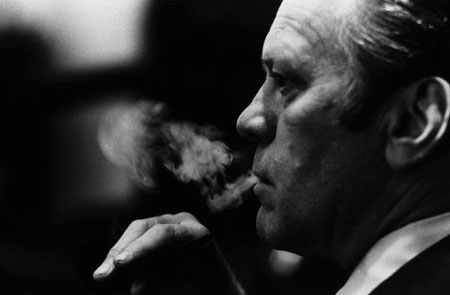
Every element of the famous Single Bullet Theory (derided as the “Magic Bullet theory” by conspiracists) has been controversial, and none more than the level of the entry wound in Kennedy’s back.
Conspiracists have incessantly claimed the bullet entered too low to be consistent with the Single Bullet Theory.
Thus it may seem especially sinister that Warren Commission member Gerald Ford “moved” the wound upward when he marked up a draft of the Warren Commission Report.
Conspiracists have seen this as blatant evidence that Ford was participating in a “cover-up,” concealing the true nature of the wound to implicate Oswald and conceal a conspiracy.
George Michael Evica of JFKlancer.com calls Ford’s correction a “terrible fiction.”[1] Robert Morningstar, another conspiracy theorist, says Ford is responsible for “the most significant lie in the whole Warren Commission report.”[2] Anthony Marsh accuses Ford of performing “verbal plastic surgery,” moving the wound through the draft report edits.[3]
So what are these sinister edits that conspiracists claim had a nefarious effect?
In 1997 the Assassination Records Review Board released the personal documents held by a member of the Warren Commission: legal counsel J. Lee Rankin. Among these documents is a draft of the Commission Report marked up by Gerald Ford. The marked up draft page referred to by conspiracy theorists eventually became page 3 of the final report. So, did Ford move the wound or was he simply correcting the draft?

Let’s first look at the draft marked up by Ford (right). The sentence in questions states, “A bullet had entered his back at a point slightly above the shoulder to the right of the spine.” Ford’s edits changed the sentence to, “A bullet had entered the back of his neck at a point to the right of the spine.” Ford’s edits did make it into the final draft (WCR3) with one addition, “A bullet had entered the base of the back of his neck and slightly to the right of his spine.”
Was this sinister?
Note that the original draft appears to be inconsistent. “Above the shoulder” would seem to be in the neck, rather than in the back.
Further, Ford would have seen the Rydberg drawing (see here) made by a naval corpsman under the direction of autopsists James Humes and J. Thornton Boswell. Humes and Boswell did not have the autopsy photos and x-rays on hand to use as a reference.

The Rydberg drawing clearly shows the wound in the neck, not the back.
The drawing, in fact, is incorrect, as the photo of Kennedy’s back (not available to researchers until years later) shows [link]. However, Ford would have had no way of knowing that.
Is there other evidence that Ford should have known about that would have contradicted the “neck” placement?
The evidence most often cited by conspiracy theorists for a low entry location is the autopsy face sheet (left). The wound on the face sheet drawing is in the back, too low to be consistent with the Single Bullet Theory, but the drawing is misleading. Note that the body on the face sheet is not drawn anatomically to scale as the shoulders slope quite a bit. The annotations next to the drawing indicate “14 cm from rt acromion” and “14 cm below tip of rt mastoid process.” The right acromion is the right shoulder joint and the right mastoid process is the bony protrusion behind the right ear. This measurement is consistent with an entry wound at the level of T1 (the first thoracic vertebra) and also consistent with the Single Bullet Theory.
So did Ford move the wound? The simple answer is no. Ford was a member of the commission, reviewing the draft written by the legal staff and making corrections as he saw fit.[4] Ford studied Economics while at the University of Michigan, not anatomy. More importantly, Ford saw the Rydberg drawings done for the Warren Commission,[5] which inaccurately placed the wound in the back of Kennedy’s neck. Given that Ford almost certainly did not know where 14 cm. below the right mastoid process was, it makes sense that he would trust the Rydberg drawings and would correct the draft to be consistent with it. As noted, the Commission was not allowed to review the autopsy photos, which is why Rydberg was commissioned to create medical drawings of the wounds based on testimony from Humes and Boswell.
Of course, no change in a verbal description can change where the wound really was. The autopsy photos show it in the back at the level of T1 and the x-rays show a fracture of the transverse process of the first thoracic vertebra (likely indicating that the bullet traversed the torso there). That’s consistent with the Single Bullet Theory, and nothing Ford (or any conspiracist) wrote can change that.
[4] Jean Davison post on alt.assassination.jfk. Davison’s posts were a key resource used in writing this essay.
[5] Ford was present during the testimony of Commander Humes when the Rydberg drawings were presented to the Commission (2H347, 349, 350)